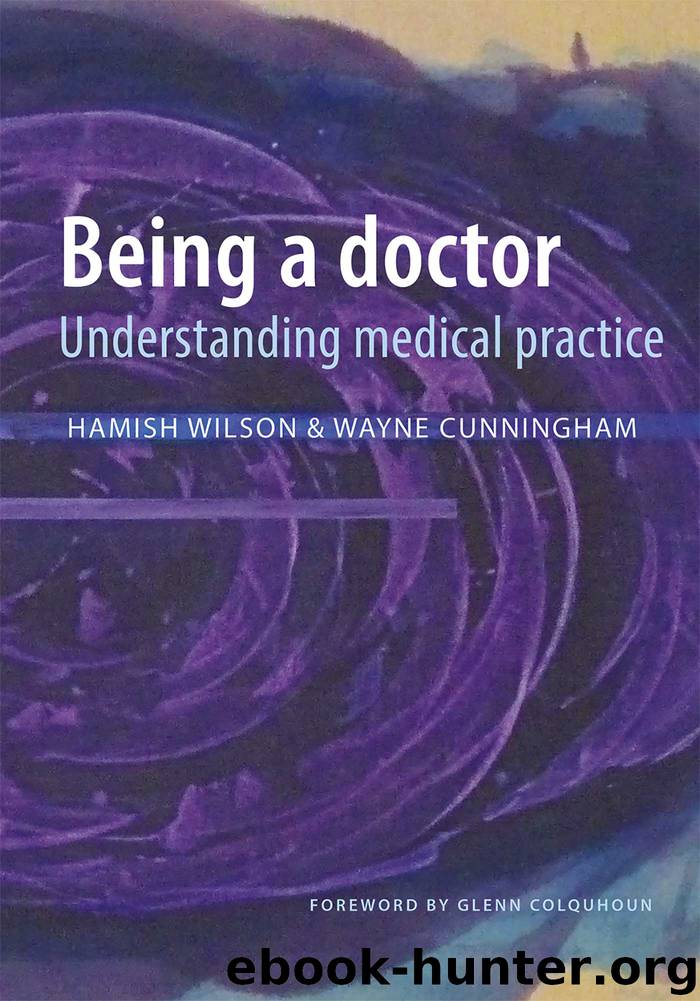Being a Doctor by Hamish Wilson

Author:Hamish Wilson
Language: eng
Format: epub
Publisher: Otago University Press
Predisposing factors for medical school and workplace stress
It is tempting to attribute the occupational hazards listed above to the stresses of medical work. However, there is increasing evidence that the personal attributes of those who choose a medical career may also increase vulnerability to work-related stress. In other words, doctors may be predisposed to psychological problems in relation to clinical work.
The first longitudinal study to explore these relationships was published in 1972, when Vaillant compared 47 physicians in the US with matched controls (i.e., against other professionals) over a period of 30 years. He found that only doctors with the ‘least stable’ childhoods and those with problems in ‘adolescent adjustment’ were vulnerable to occupational hazards such as poor marriages, increased use of drugs and alcohol, and the use of psychotherapy (as a marker of distress).(21)
Since then, further studies have looked at medical students as well as practising doctors, identifying links between childhood experiences and choice of a health professional career.(22) In 1986, Firth found that medical students in the UK had higher rates of stress than other groups in the general population, estimating that rates of ‘emotional disturbance’ were over 30 per cent.(23) Notably, ‘relationships with consultants’ were the cause of the ‘strongest negative feelings’.
Firth-Cozens identified ‘self-criticism’ as a strong predictor of subsequent stress and depression.(24) Such traits were more predictive for work-related stress than actual hours of work. Similarly, avoidance of significant issues, denial or ‘dismissing events’ appears to create more stress in both students and practitioners.(25, 26) We will return to this important observation about coping strategies soon.
McManus et al. tracked over 1600 UK medical students from the start of medical school until about five years after graduation, finding that stress, burnout and job satisfaction correlated with personality traits – such as ‘neuroticism’ (the tendency to experience more negative than positive emotions) – that they had identified earlier. They linked a greater sense of personal accomplishment with ‘deep’ (as opposed to ‘surface’) approaches to learning. Stress was greatest in those with high neuroticism scores, low extraversion scores and low conscientiousness scores. They concluded: ‘High perceived workload and poor support are therefore determined as much by the doctors themselves as by specific working conditions’.(27)
These reports hint at possible problems with perfectionism, but it is useful to distinguish between ‘adaptive’ and ‘maladaptive’ traits. Adaptive perfectionism is related to conscientiousness and striving for achievement, while maladaptive is related to excessive concerns about the perceptions of other people (i.e. socially prescribed perfectionism). Enns and others showed, first, that medical students are quite different from arts students and, second, that adaptive perfectionism is correlated with expectations of performance. Maladaptive perfectionism is correlated with distress and negative affect, and also predictive of symptoms of depression later in training.(28)
A possible explanation for these links is as follows. Most medical schools have entry criteria that require detailed study and knowledge recall. Such intense study requires a particular conscientiousness. Furthermore, the sheer volume of information required can mean that students feel they never know quite enough, while
Download
This site does not store any files on its server. We only index and link to content provided by other sites. Please contact the content providers to delete copyright contents if any and email us, we'll remove relevant links or contents immediately.
| Administration & Medicine Economics | Allied Health Professions |
| Basic Sciences | Dentistry |
| History | Medical Informatics |
| Medicine | Nursing |
| Pharmacology | Psychology |
| Research | Veterinary Medicine |
Periodization Training for Sports by Tudor Bompa(8170)
Why We Sleep: Unlocking the Power of Sleep and Dreams by Matthew Walker(6618)
Paper Towns by Green John(5090)
The Immortal Life of Henrietta Lacks by Rebecca Skloot(4525)
The Sports Rules Book by Human Kinetics(4294)
Dynamic Alignment Through Imagery by Eric Franklin(4118)
ACSM's Complete Guide to Fitness & Health by ACSM(3989)
Kaplan MCAT Organic Chemistry Review: Created for MCAT 2015 (Kaplan Test Prep) by Kaplan(3940)
Introduction to Kinesiology by Shirl J. Hoffman(3726)
Livewired by David Eagleman(3684)
The Death of the Heart by Elizabeth Bowen(3552)
The River of Consciousness by Oliver Sacks(3541)
Alchemy and Alchemists by C. J. S. Thompson(3451)
Bad Pharma by Ben Goldacre(3357)
Descartes' Error by Antonio Damasio(3230)
The Emperor of All Maladies: A Biography of Cancer by Siddhartha Mukherjee(3066)
The Gene: An Intimate History by Siddhartha Mukherjee(3047)
The Fate of Rome: Climate, Disease, and the End of an Empire (The Princeton History of the Ancient World) by Kyle Harper(3003)
Kaplan MCAT Behavioral Sciences Review: Created for MCAT 2015 (Kaplan Test Prep) by Kaplan(2940)
